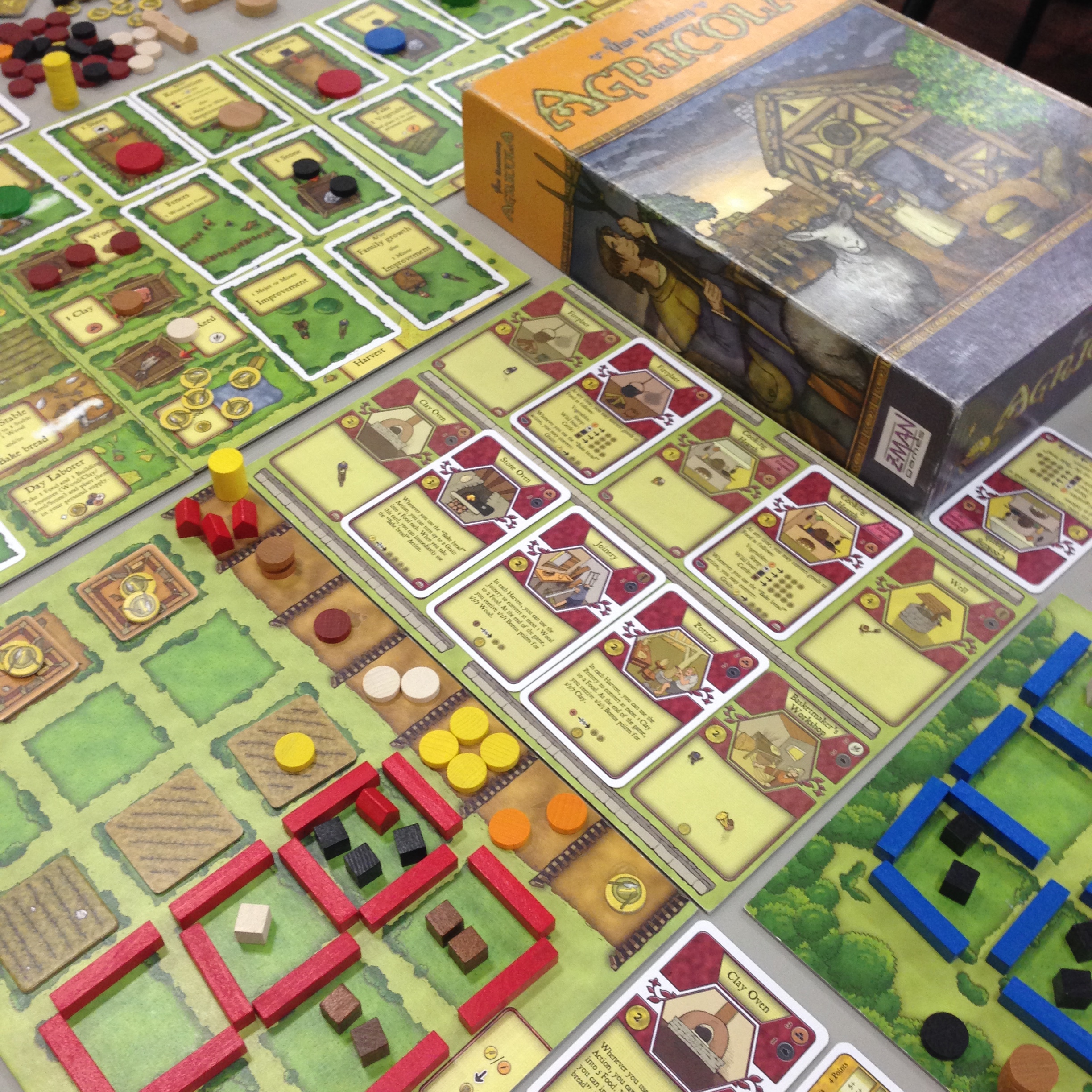The contents of this article are excerpts from Dave Choi’s Agricola Strategy write up. The full guide can be found at http://dave-choi.github.io/strategy/agricola/index.html
The way scoring works in Agricola is that you’re rewarded for diversity. Your first grain takes you from -1 point to 1 point, which makes it effectively worth 2 points. Every grain after the first results in diminishing returns. This applies to every scoring category besides fields, with which you don’t transition from -1 to 1 until your second field.
Because the game rewards you for diversifying, it’s tempting to try to take a balanced approach throughout the game, doing some ranching livestock, and some planting crops. Playing this way will tend to give you an early lead, but point gains will tend to drop off later on, and you’ll likely end up with 30-40 points, which isn’t bad, but you can do better. Points only matter at the end of the game, and confer no advantage, so an early lead is meaningless.
The problem with a balanced approach is that it’s inefficient. To convert grain to food efficiently, you need an oven. To convert animals to food, you need a Fireplace or Cooking Hearth. Getting both requires several actions gathering resources, and building the improvements. Furthermore, grain must be planted to be an efficient source of food, which requires plowing and sow/bake actions, and pastures must be built to support livestock breeding, and trying to do both will prevent you from being great with either. i.e. You won’t have enough fields or you won’t have enough pastures.
What’s generally better is to specialize in one or the other, and fill in the gaps once your primary food engine is established and fulfilling your needs. For example, getting a Cooking Hearth and getting a set of each kind of animal, with space to breed them, provides you with 9 food per harvest, which means you don’t have to spend actions securing food, and can then spend them plowing fields, and taking seed crops.
By specializing, you can develop the infrastructure necessary, and utilize bonuses from improvements and occupations to feed efficiently. If you keep finding yourself taking grain to bake, or frequently taking animals to eat, you’ve failed to develop your farm properly.
Generally speaking, baking is not advisable unless you have a hand that strongly supports it. A Clay Oven converts up to 1 grain to 5 food, which is a good deal, but it requires an action that combines with the sow action, which you usually aren’t going to want to do more than once per harvest. With a large family, that means you will have to supplement your food income.
Add to this, there’s only one sow/bake spot on the board, regardless of the number of players. When the player count is low, there are plenty of animals, so why bake? When the player count is high, the sow/bake spot is highly contested, because even ranchers need to sow crops, so why bake? You really need a good reason.
Cues to Bake
Certain occupations and improvements can make baking a solid choice. There are some cards that will make it seem like you have a strong baking hand, but it can sound better than it really is. Generally, you’ll need a combination of a few.
Because you don’t really want to spend 5 actions setting up 2 grain fields before first harvest, and around 3 actions collecting resources and building an oven, look for ways to save on these actions.
The reason you need two fields, normally, is because taking 1 grain is very inefficient, and you want to sow each time you bake. The Corn Scoop, Market Crier, Market Woman, Seed Seller, Grain Cart will all supply multiple grain per action, which will mitigate the need for early double fields.
Serf provides you with a grain before every sow/bake action, so you can bake effectively with no fields, even, though it’s still better to get sows in with the action. The Baker also lets you get away with fewer fields, because you can bake after harvesting, which gives you tremendous freedom in your worker placement. Playing the Baker also gives you a free bake action as you’re playing the occupation, which you shouldn’t waste.
Field Watchman lets you plow a field every time you take a grain, which makes setting up grain fields totally effortless. The Acreage minor improvement gives you two fields to plant grain in for free, if you have one occupation.
The Bakehouse, Baker’s Kitchen, and Baker’s Oven all provide the same utility, but differ by stone cost and victory points. Stone is hard to get, so cheaper is better. These let you bake 2 grain into 10 food, which is super efficient, and will leave you with huge surpluses of food if used every harvest, and will buy you breathing room when you can’t work it in. The fact that you can bake as soon as you play them gives you a lot of space to work.
The Millstone adds 2 food to baking actions (this happens once per baking action, not per grain baked), which can make a Clay Oven able to stand on its own, but I’ll just as often use it to enhance the baking on my Cooking Hearth, making it the most flexible cooking improvement possible. Really not bad for 1 stone.
In 2 and 3 player games, it’s either impossible to get early stone for an oven, or very inefficient (using the 1 building resource space in 3P). The Baking Tray lets you reduce the cost of each oven by one resource of your choice, and turns them into minor improvements for you, letting you lump building them in with family growth, or starting player. I don’t believe it’s enough to justify baking on its own, but it helps tip the scale that way.
Cards that let you get a bunch of different kinds of animals, I think, are a good incentive to bake. Animal Handler, Clay Seller, Farmer, to a certain extent, will let you fill out your farm at the end of the game, and reinforce baking strategies.
Cards that add extra opportunities to bake will make baking a little safer, as you’ll have alternatives to the sow/bake space. Bread Paddle, Flail and Threshing Board fall into this category.
There are a bunch of cards that will let you sow extra onto a field, but I think these generally work better for ranchers, and aren’t a good incentive to bake. If you’re baking, you’re sowing often, and shouldn’t have trouble maxing out your crops.
There are more cards, but if I don’t see a few of these, I generally won’t consider baking.
To sustain a baking engine, you’ll generally need two grain fields fairly early, in order to be able to bake, and to have extra grain to sow, to continue your baking cycles. Without improvements, you’re generally looking at sowing 2 fields before the first harvest, or sowing once before the first harvest, and again before the second. This is a lot of actions to spend at a time when you generally want to be focusing on house expansion and family growth. Occupations and improvements that provide more grain can really help to soften this blow. Seasonal Worker, Corn Scoop, Seed Seller, etc. Plows are actually not that useful for bakers because by the time you can play them, it’s generally already too late to get your fields going.
Later in the game, wood is less contested, so try to position for highly efficient wood grabs so you can fence all at once to fill in your farm.
Ranching utilizes a Fireplace or Cooking Hearth and allows you to convert animals and vegetables to food at any time. They also provide a low efficiency bake option, which can be a lifesaver sometimes. In the absence of a strong reason to bake, you should default to ranching.
To ranch effectively, you need space for your animals to breed, which means at least a fenced pasture, or two stables, which will both cost you 4 wood.
An effective way to get your ranch started is to collect 9 wood, 2 reed, and build your first wooden room and two stables, commonly referred to as “breeding stables”. This allows you to hold two animals in your stables and breed one into your home, which you can eat every harvest. The breeding animals that you hold onto also provide you with extra flexibility to skip normal feeding actions to capitalize on high value resource grabs and the like. One more benefit to breeding stables is that it gives you the capacity right away to hold 3 types of animals, which is worth 6 points. So if you keep getting blocked on wood with which to fence, you’re at least not blocked on points for animals in the late game.
For 6 more wood, you can fence a separate 1x2 pasture that will allow you to breed a second type of animal. Or for 7 wood, you can fence your stables.
You may be better off just eating your initial sheep, so you can afford to keep a breeding pair of boar, and use the extra flexibility to try to grab more wood for full fences, as they are the easiest way to cover ground and clear negatives.
Because of the different actions that are available with different numbers of players, there are some considerations to be made for the relative demand for resources and actions.
In general, as the number of players goes up, the availability of building resources goes with it, but access to food sources decreases. e.g. A five player game gets the same number of spawned sheep, boar and cattle as a 2 player game, but it’s much easier to get the wood necessary to support breeding.
2 players, there’s very little of every resource to go around. Baking is generally inadvisable, but especially so with 2 players. Letting your opponent take all the animals for easy food is basically suicide, and you have no access to stone with which to build ovens until rounds 5-7. Heads up play is very directly confrontational, and deserves its own section.
3 players, reed is incredibly sparse, and wood and clay are somewhat easier to manage. It also includes the wildcard building resource spot, which makes it easier to get an early oven, or play improvements like the Axe, which requires stone pretty early.
4 players, resources are fairly plentiful, but there’s still only one spot to build rooms, and one spot to grow your family, so jockeying for position on those actions is a big part of 4er play.
5 players, there’s a crazy amount of clay, and there’s a little less stone and reed per capita. There’s also heavy competition over cooking hearths, so prioritize them a little more heavily. There’s an additional build room space, and family growth space, compared to the 4 player board, so it’s much easier to do that as convenient.
-Edited by Jackie
( Dave’s comprehensive guide covers much more than what we have discussed in this article. For a full breakdown of how to win Agricola, please visit his original post )
http://dave-choi.github.io/strategy/agricola/index.html
Agricola is designed by Uwe Rosenberg and currently published by Lookout Games in USA.

